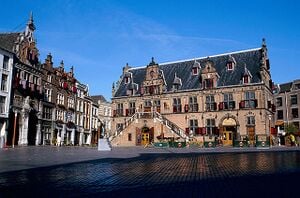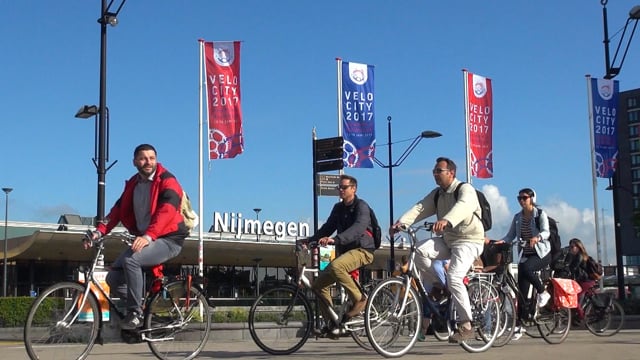Nijmegen community action

Nijmegen is a municipality and a city in the Dutch province of Gelderland. It is situated on the Waal river, close to the German border. Nijmegen is the oldest city in the Netherlands, the first to be recognized as such in Roman times, and in 2005 celebrated 2,000 years of existence. The municipality is part of the "Stadsregio Arnhem-Nijmegen" (Arnhem-Nijmegen urban region (neighbouring city, 15 km (9 mi) north)), a metropolitan area with 736,107 inhabitants (2011). W
Networks and sustainability initiatives[edit | edit source]
- Nijmegen European Green Capital 2018
- Green Capital Challenges, Nijmegen Green Capital of Europe in 2018.
Cycling activism[edit | edit source]
With 250 000 bicycles in Nijmegen, cycling accounts for 65 % of journeys to the city centre and Radbound University. The city boasts 60km of cycle superhighways, with another 20km underway[1]
Like most Dutch cities, bicycles are an important mode of transport. The city is connected to Arnhem, 18 km (11 mi) to the north, by a "fietssnelweg" (fast cycle highway) which crosses the Snelbinder bridge in the city. During 2010–2012 the cycle highway received upgrades to further encourage the use of bicycles for transport between Nijmegen and Arnhem. In May 2016, the Dutch Fietsersbond (Cyclists' Union) awarded the 2016 Fietsstad (Cycling City) award to the city of Nijmegen. W
Sharing[edit | edit source]
News and comment[edit | edit source]
2016
Nijmegen wins European Green Capital Award 2018, Jun 22[2]
2015
Nijmegen Sharing City Embraces No-Money Abundance, January 26[3]
More room for the river Waal[edit | edit source]
To prevent flooding in the near future, the Dutch government is changing the course of more than 30 rivers throughout the country. These measures, taken along the rivers IJssel, Lek, Maas and Waal, are known as 'Room for the River'. Room for the river Waal as it passes Nijmegen is one of these measures. As part of this, the artificial island Veur-Lent was created in 2015. The river Waal not only has a sharp bend near Nijmegen, it also forms a bottleneck. In 1993 and 1995 this led to high water and floods. To prevent this from happening again and to protect inhabitants of the city and its surroundings against the water, work has been done to relocate the Waal dike in Lent and to excavate a large ancillary channel in the flood plains, creating an island in the Waal. The large scale project involves the construction of three bridges, new dikes and concrete water barriers. On the island, a project of alleged sustainable urbanism is giving birth to an urban river park with possibilities for recreation, culture, water and nature. W
References

